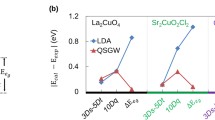Abstract
P W Anderson was a theoretical physicist. He won the Nobel Prize in 1977. He catalysed Nobel Prizes for several others. His career spanned 72 years of relentless research, filled with path-breaking contributions. He focussed on ‘here and now’ phenomena of inanimate materials and built theoretical quantum models of lasting value. He communed with nature by contemplation and study of experimental results. As a founding father, he set agenda for the field of condensed matter physics, for half a century. It is a growing fertile field now, with a web of connection to different corners of science, technology, and sometimes beyond. As a person, Anderson was remarkable. He was my long time collaborator since 1984. I had a wonderful opportunity to join hands with him when he initiated the resonating valence bond (RVB) theory of high-temperature superconductivity in cuprates in early 1987.
Similar content being viewed by others
Suggested Reading
Phil Anderson and Gauge Symmetry Breaking, Ed Witten, in PWA90: A Life of Emergence, Eds. P. Chandra, P. Coleman, G. Kotliar, P. Ong, D.J. Stein and C. Yu (World Scientific) 2016.
P W Anderson and N Itoh, Nature (London) 256, 25 (1975)
P W Anderson, M A Alpar, D Pines and J Shaham, Philosophical Magazine, A45, 227 (1982).
G Baskaran, Random Walk in Anderson Garden, in PWA90. A Life of Emergence, arXiv: 1608.08587.
T V Ramakrishnan, Anderson and Condensed Matter Physics, in PWA90: A Life of Emergence.
T V Ramakrishnan and C N R Rao, Superconductivity Today, Universities Press, 1999.
P W Anderson, Personal history of my engagement with cuprate superconductivity (1986–2010), Int. J. Mod. Phys. B25, pp.1-39, 2011, arXiv:1011.2736.
B S Shastry, Review of the book The Theory of Superconductivity in High-TcCuprates (P W Anderson), Current Science, 74, 175, 1998.
R Rajaram Nityananda, Introduction to P W Anderson’s classic article, ‘More is Different’, reprinted in this issue of Resonance.
Steven Weinberg, From BCS to the LHC, CERN Courier, 21 January 2008.
Author information
Authors and Affiliations
Corresponding author
Additional information
G Baskaran is a theoretical physicist. He studies a variety of quantum phenomena, including theory and mechanism of room-temperature superconductivity. He shares his time between The Institute of Mathematical Sciences, Chennai, Department of Physics of Indian Institute of Technology Madras and Perimeter Institute for Theoretical Physics, Waterloo, Canada.
Rights and permissions
About this article
Cite this article
Baskaran, G. Glimpses of Greatness. Reson 25, 617–628 (2020). https://doi.org/10.1007/s12045-020-0979-x
Published:
Issue Date:
DOI: https://doi.org/10.1007/s12045-020-0979-x




